Properties
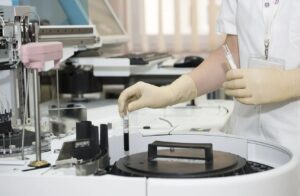
The key goals of T11 Shared facility is to facilitate cutting-edge characterization tools that enable comprehensive analysis of the electrical, magnetic and optical properties of nanoscale material systems.
The laboratory is equipped with physical property measurement system (PPMS) and magnetic property measurement system (MPMS SQUID) that allows users to investigate cryogenic transport with high magnetic fields. In the optical front, we have a range of steady state and time resolved spectroscopy and microscopy tools including Raman, photoluminescence and femtosecond pump-probe transient techniques.
How to Access Facilities
To access the facility, the following steps must be followed:
Contact Ngee Hong Teo (mtnh@nus.edu.sg) and Tiho (tiho@nus.edu.sg) to schedule a project meeting.
Register your personal and project details with PPMS (https://ppms.asia/nus-cde/login/)
Schedule a training or service session with our staff.
Service & Booking Fees
Booking fees will differ for NUS and Non-NUS members. More details will be published soon.
Our Partners
Find out more about our partners in Singapore:
Electron Microscopy Facility (EMF)
NUS Center for Bioimaging Sciences (CBIS)
NUS YLL School of Medicine Electron Microscopy Unit (EMU)
NTU Facility for Analysis, Characterization, Testing and Simulation (FACTS)
A*STAR IMRE Advanced Characterization and Instrumentation (ACI) Department
Contact Us
Research Fellow : Tiho@nus.edu.sg
Lab Technologist : Mtnh@nus.edu.sg
Communications : Samuel@nus.edu.sg
T11 Shared Facilities
Level 11
T-Lab Building
5A Engineering Drive 1
College of Design and Engineering
Singapore 117411
FACILITIES
Click on the icon/tab to learn more about our facilities at NUS T11:
Material synthesis
Structural Characterisation
Properties
Devices
Properties Facilities
Ultrafast Optical Spectroscopy
Discover more, Click here.
The following are available at our facility: Two Independently Tunable Optical Parametric Amplifiers, Ultra-Stable, kHz Repetition-Rate, Ti:Sapphire Amplifier System, Narrow Bandwidth Optical Parametric Amplifier, Time-Resolved Photoluminescence Spectroscopy (TRPL), Two Photon Microscopy.
Magnetic Characterization
Discover more, Click here.
The facilities consist of Surface Stylus Profiler: MPMS SQUID.
Optical Microscopy
Discover more, Click here
The facilities consist of Nikon Microscope, Raman Spectrometer, UV-VIS-NIR spectrometer, Fluorescence Inverted Microscope (Nikon Eclipse Ti2-E).
Ultrafast Optical Spectroscopy
Note: Currently the equipments are down - Two Independently Tunable Optical Parametric Amplifiers, Ultra-Stable, kHz Repetition-Rate and Ti:Sapphire Amplifier System
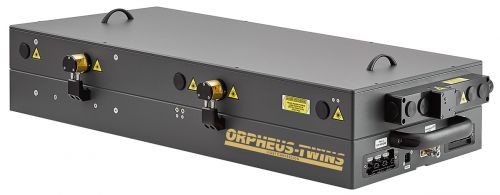
Two Independently Tunable Optical Parametric Amplifiers
Two independently tunable optical parametric amplifiers designed for flexible pump parameters and OPA configuration. Both OPA units are integrated into a single housing and share the same white light seed for amplification. The design of this OPA enables hands free wavelength tuning, optional automated wavelength separation and the possibility of generating broad band mid-infrared radiation, in the region of 4 µm – 16 µm, with a passively stable Carrier Envelope Phase (CEP).
Technical Specifications
- Two OPA units in single compact housing
- 210 nm – 16000 nm tunable wavelength
- Single pulse – 1 MHz repetition rate
- Up to 40 W pump power
- Up to 0.5 mJ pump energy (2 mJ upon request)
- Broadband and short-pulse (<100 fs) versions
- CEP stable mid-IR output
- Integrated spectrometers for monitoring OPA output wavelength

Ultra-Stable, kHz Repetition-Rate, Ti:Sapphire Amplifier System
This amplifier offers 3 mJ at 1 kHz with pulse durations of ~100 fs.
Technical Specifications:
- Model: Libra_F-1K-HE-230
- Integrated Vitara seed laser, Evolution pump laser, regenerative amplifier andcompact stretcher/compressor for ultimate stability and reliability
- E-2 Engine, high performance and high reliability regenerative amplifier module, provides highest energy and efficiency with M2 <1.3
- Thermally-stabilized amplifier platform for reliable long-term performance
- Innovative Ti:Sapphire rod assembly for improved beam quality and thermal management
- Proprietary conditioning optics for optimized output beam quality
- Stability <0.5% rms Application
- Biology
- Photochemistry
- Solid State Research
Narrow Bandwidth Optical Parametric Amplifier
Second Harmonic Bandwidth Compressor (SHBC)-TOPAS-400-WL system is a nonlinear optics device devoted for generation of a narrow bandwidth (3 – 20 cm-1) continuously wavelength tunable pulse when pumped by a femtosecond pulse with bandwidth of 150 – 500 cm-1. The device is pumped by a fundamental harmonic of a femtosecond Ti:sapphire laser amplifier and continuously covers wavelength range from 240 to 1600 nm. With optional frequency mixers this range can be extended up to 10 microns.
Technical Specifications:
- Converts femtosecond pulses to < 20 cm-1 bandwidth
- Pump energy up to 4 mJ
- Tuning range spanning from 240 nm to 10 µm, computer controlled
- High output stability throughout the entire tuning range
- Grating frequency selector for bandwidth limited output
Other Ultrafast Optical Spectroscopy

Time-Resolved Photoluminescence Spectroscopy (TRPL)
The fluorescence lifetime is characteristic for each fluorescent or phosphorescent molecule and can thus be used to characterize a sample. The setup is equipped with the PicoHarp 300, which is a high-end, easy to use, plug and play Time-Correlated Single Photon Counting (TCSPC) system. The PicoHarp 300 can be also used for various applications that can make use of a TCSPC and/or time tagging system with independent channels, such as:
Technical Specifications:
- 65536 histogram time bins, minimum width 4 ps.
- Count rate up to 10 million counts/sec.
- Time-correlated single photon counting machine with usb interface.
- Detector: Single-photon avalanche diode (Manufacturer: Micro Photon Devices)
- Fully software-controlled triggering and data acquisition.
- Measurements on micro-sized samples enabled with 20x, 40x and 100x objectives.
- Users are supposed to bring all optics required such as beam-splitter, filters, dichroic mirrors and the spectrometer
Two Photon Microscopy
Optical nonlinearity measurements of micro-sized samples can be accurately measured with this two-photon inverted-microscope.
Technical Specifications:
- Nikon Eclipse-Ti
- Bright field (with in-built color and ND filter wheels) and two-photon microscopy imaging with manual X-Y stage.
- Two-photon imaging is possible with inbuilt PMT and accessories.
- Coarse/fine focusing of infinity-corrected objective with magnifications 20x, 40x and 100x.
- Manual turrets with 6 slots.
- Excitation beam: 1030 nm or 515 nm (Second Harmonic) with ~150 fs, 1 MHZ, 70 mW (max. average power for 1030 nm).
- Users are supposed to bring all optics required such as beam-splitter, filters, dichroic mirrors and the spectrometer.
Magnetic Characterization
Note: Currently this equipment is unavailable.
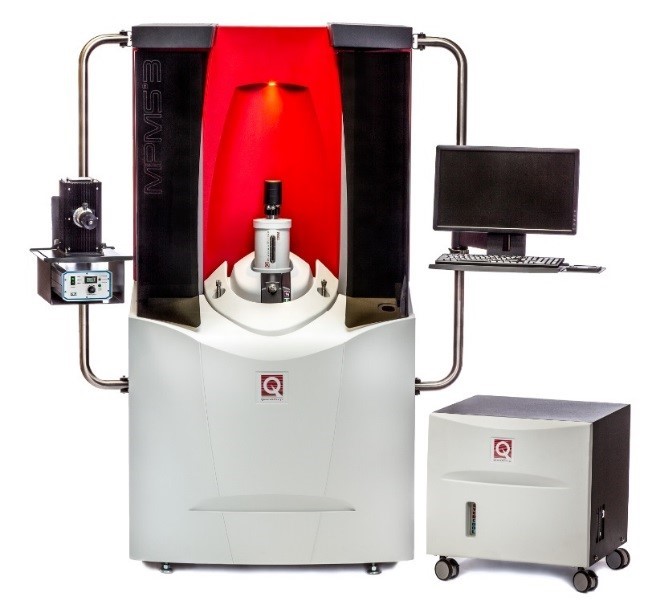
MPMS SQUID
MPMS SQUID is a vibrating sample magnetometer from Quantum Design, to measure temperature and field dependent weak magnetic signatures of thin films and powder samples. Magnetometry of thin films can be performed in in-plane and out-of-plane geometries by using a quartz and straw holders, respectively. Powder samples, on the other hand, are to be measured inside a custom designed QD capsule which is placed inside a brass holder. Users can perform Magnetization vs Field curves (M-H) at different temperatures, or perform Field-Cooled or Zero-Field-Cooled Magnetization vs Temperature scans (M-T)
Technical Specifications:
- Temperature Range: 3-400K
- Magnetic Field: 0-7T
- Measurable Moment Range: 0.1 u emu to 10 m emu (stronger magnetic samples are strictly not to be measured in this SQUID-VSM)
- Sample Size Films: Area less than or equal to 5mm*5mm
- Sample Size Powder: Powder volume should be securely contained in the capsule
- Cool/Warm Rates: 10-20C/min
- Base He Pressure: Less than 8Torr (during measurement)
Optical Microscopy
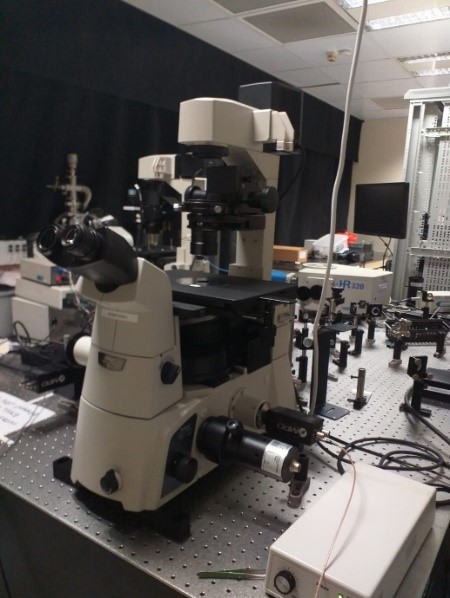
Nikon Microscope
NIKON Universal inverted microscope: Configured for use with additional motorized components. The Eclipse Ti-U uses Nikon’s world-famous CFI60 optical system and a wide choice of objectives for bright field, dark field, fluorescence, and phase contrast, DIC and modulation contrast microscopy techniques.
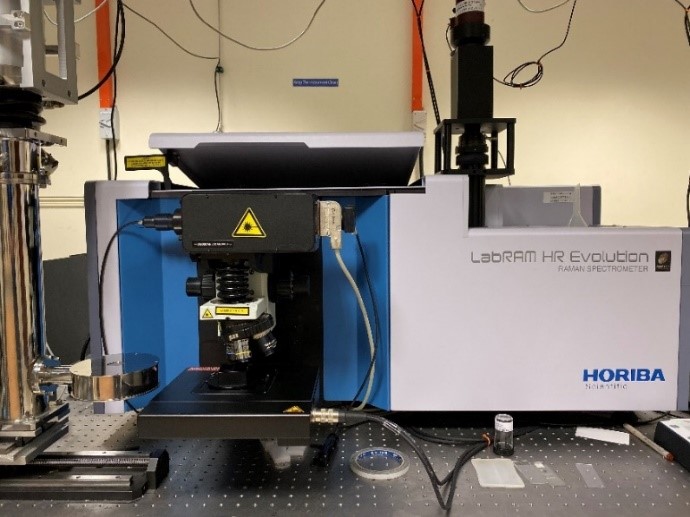
Raman Spectrometer
The LabRAM HR Evolution Raman microscopes are ideally suited for both micro and macro measurements, and offer advanced confocal imaging capabilities in 2D and 3D. The true confocal Raman microscope enables the most detailed images and analyses to be obtained with speed and confidence. With guaranteed high performance and intuitive simplicity, the LabRAM HR Evolution is the ultimate instrument for Raman spectroscopy. They are widely used for standard Raman analysis, PhotoLuminescence (PL), Tip Enhanced Raman Spectroscopy (TERS) and other hybrid methods.
Technical Specifications
- JY Horiba LabRAM Evolution
- Detector range- 550-1050nm, > 70cm-1
- Excitation Laser: 488 nm & 514 nm
- Able to measure both Raman and Photoluminescence
- Spatial mapping of surfaces
- Temperature Range: 10 K – 300 K
- Horiba Jobin Yvon LabRAM | Raman Lab

